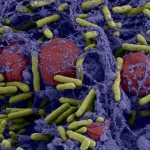Lien vers Pubmed [PMID] – 15294896
J. Biol. Chem. 2004 Oct;279(43):45057-67
A functional fluorescent neurokinin NK2 receptor, EGFP-NK2, was previously used to follow, by fluorescence resonance energy transfer measurements in living cells, the binding of its fluorescently labeled agonist, bodipy-neurokinin A (NKA). Local agonist application suggested that the activation and desensitization of the NK2 receptors were compartmentalized at the level of the plasma membrane. In this study, fluorescence recovery after photobleaching experiments are carried out at variable observation radius (vrFRAP) to probe EGFP-NK2 receptor mobility and confinement. Experiments are carried out at 20 degrees C to maintain the number of receptors constant at the cell surface during recordings. In the absence of agonist, 35% EGFP-NK2 receptors diffuse within domains of 420 +/- 80 nm in radius with the remaining 65% of receptors able to diffuse with a long range lateral diffusion coefficient between the domains. When cells are incubated with a saturating concentration of NKA, 30% EGFP-NK2 receptors become immobilized in small domains characterized by a radius equal to 170 +/- 50 nm. Biochemical experiments show that the confinement of EGFP-NK2 receptor is not due to its association with rafts at any given time. Colocalization of the receptor with beta-arrestin and transferrin supports that the small domains, containing 30% of activated EGFP-NK2, correspond to clathrin-coated pre-pits. The similar amount of confined EGFP-NK2 receptors found before and after activation (30-35%) is discussed in term of putative transient interactions of the receptors with preexisting scaffolds of signaling molecules.

